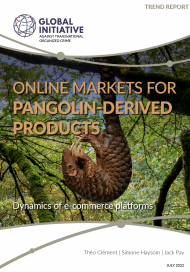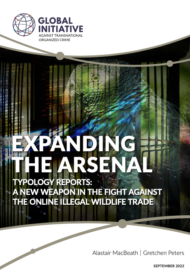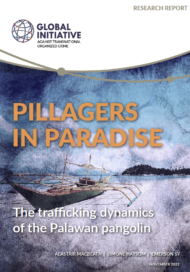Posted on 09 Dec 2022
After three years on ice, the 19th meeting of the Conference of the Parties (CoP) to the Convention on International Trade in Endangered Species of Wild Fauna and Flora (CITES) was badly needed to pick up momentum on international efforts to regulate the international wildlife trade. For three years, reduced activity due to the COVID-19 pandemic had put such in-person meetings on hold, and the Global Initiative Against Transnational Organized Crime (GI-TOC), like thousands of other delegates, enforcement agencies and NGOs, leapt at the opportunity to participate in the world’s largest meeting with illegal wildlife trafficking on the agenda.
The CoP, which took place in Panama City in November, saw a flurry of new decisions. Out of the 52 proposals put forward, 46 were adopted, bringing more than 500 new species under the convention, including sharks, lizards, turtles, fish, birds, frogs and more than a hundred tree species, all of which have seen declines in their numbers in recent years. The conference saw repeated fault lines on particular issues, most notably the reopening of the international ivory trade. Yet the majority of parties continued to support a ban. It is hoped that these decisions will help tackle one of the three main threats to wild plants and animals – namely, overexploitation.
However, the GI-TOC’s focus for the conference was not on supporting or objecting to listings, but rather to contribute towards improving the regulation of any trade, be it illegal or partially restricted. As CITES works through subjecting international trade in specimens of selected species to regulations, it is crucial that the effectiveness of and ability to enforce such regulations is understood to ensure that the decisions of CITES members carry weight.
A recent report published by the GI-TOC highlights how the wildlife trade has become a complex social, economic and criminal phenomenon that is difficult to regulate, and for which prohibitions alone are not enough. Instead, approaches need to bring together a broad spectrum of actors and design evidence-led interventions that feeds into a strategic and holistic response.
Therefore, the main contribution the GI-TOC made at the CoP was in the form of two side events designed to facilitate discussions related to the illegal wildlife trade from an organized crime perspective and to consider how responses can be improved. The first of these explored the practical realities of international enforcement cooperation and the second discussed the need for better responses due to the increasingly online nature of the illegal wildlife trade.
International wildlife crime enforcement cooperation
The illegal wildlife trade is an inherently global problem requiring effective international enforcement cooperation to mount a successful response. CITES was conceived in the spirit of such cooperation, and it recognizes its importance to safeguard certain species from overexploitation. However, despite efforts to improve international cooperation over the past 15 years, there remains a disconnect between the attempts to improve cooperation and the experience on the ground. This raises several key questions surrounding the effectiveness of the current cooperation regime, namely, whether it is suitable to respond to the growing threat, what the barriers to effective cooperation are at the practical level and how can these be overcome.
The GI-TOC, in partnership with the Wildlife Conservation Society (WCS), explored these issues in a panel discussion with officials from the Nigerian Customs Service and the Anti-Smuggling Bureau of the China Customs General. This is part of an ongoing project between the GI-TOC and the WCS designed to investigate the practical realities of international cooperation to provide a set of recommendations to enhance prospects of success.
The panel considered the importance of individuals in effective cooperation regimes and how trust is essential due to the sensitivity of information and the prevalence of corruption as an enabler in the illegal wildlife trade. The participants also explored issues related to institutional capacity and lack of incentives for cooperation and how NGOs can play a role facilitating networking and building relationships between countries.
These issues are crucial for ensuring the effectiveness of the decisions made at the conference, as international enforcement cooperation across regions is essential if such regulations are to be constructive. The need for international cooperation is apparent from the international trade in shark fin, the main markets for which are in Asia. Shark fin, however, is primarily sourced from productive fishing groups near the coasts of Latin America and Africa, thus requiring collaboration between the regions.
The online illegal wildlife trade
Despite being primarily a trade agreement, CITES recognizes the role criminal actors play in the trade in protected species. At the previous CoP, held in 2019, parties adopted decisions relating to ‘wildlife crime linked to the internet’, which outlined how parties can better respond to the online illegal wildlife trade by sharing best practices to allow for the investigation and targeting of the internet-based trade of CITES species. Although the recognition of the problem is an important step, the GI-TOC believes that the magnitude of the online illegal wildlife trade demands a holistic approach, which would involve equally nation states, civil society organizations, law enforcement agencies and the private sector.
The GI-TOC and the Alliance to Counter Crime Online (ACCO) were joined by wildlife trade expert Patricia Tricorache to discuss the evolving challenges and emerging opportunities associated with the online illegal wildlife trade. We also explored how the GI-TOC’s Market Monitoring and Friction Unit (MMFU) and the ACCO are exploiting several opportunities. The first is the use of machine-learning technology to map online markets; the second is the development of community tool reports designed to share our knowledge to the wider community; and the third is through advocating for improved policy responses from governments and multilateral forums, such as CITES.
The work of the MMFU has identified how exotic pets, such as Indonesian birds, are available for sale in large numbers on internet sites and social media platforms, which, due to the contribution social media plays in shaping consumer dynamics, are driving demand for these protected species. Now that CITES is regulating other exotic pets, such as glass frogs, it will be interesting to see whether social media platforms will clamp down on wildlife trade on their platforms.
The way forward
The ongoing work linked to both these events aims to drive better responses to the illegal wildlife trade from all actors, including states, law enforcement agencies, civil society organizations, communities and the private sector. Such approaches need to be evidence-based to be effective. Furthermore, they should not rely on prohibitions but rather make efforts to understand the practical realities driving the trade, such as within communities, so that constructive and long-term interventions can be implemented to ensure the maximum effectiveness of the decisions made at the CITES CoPs.



